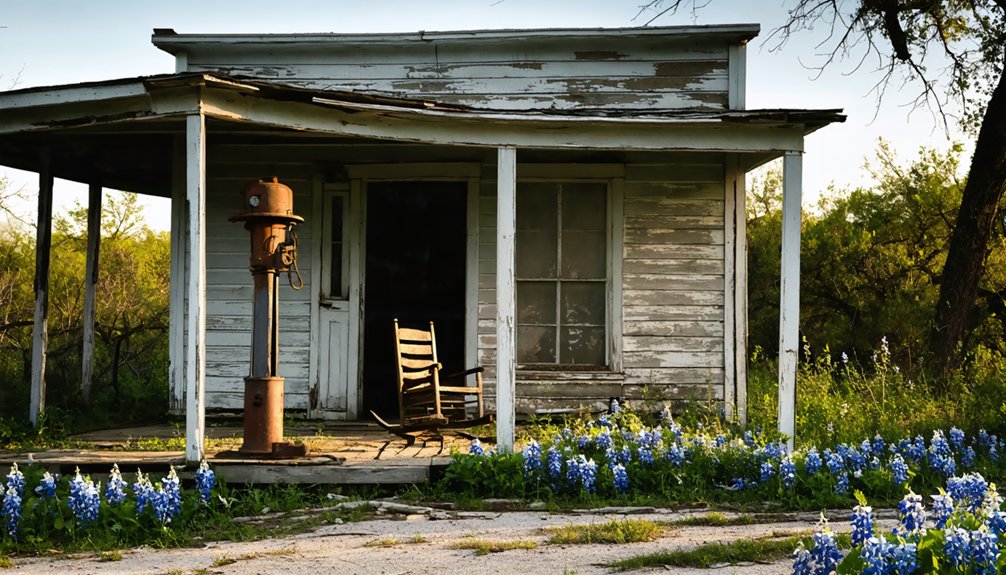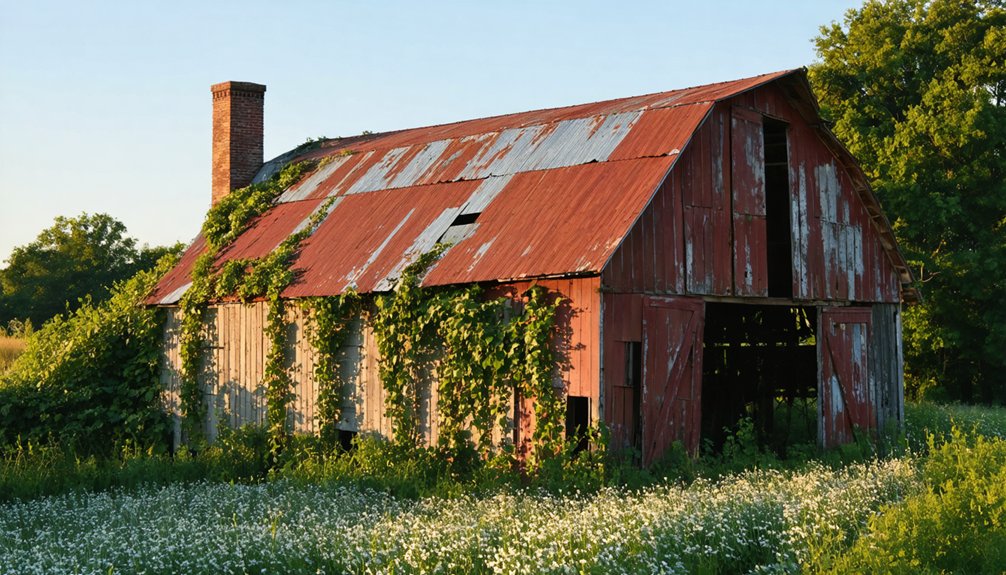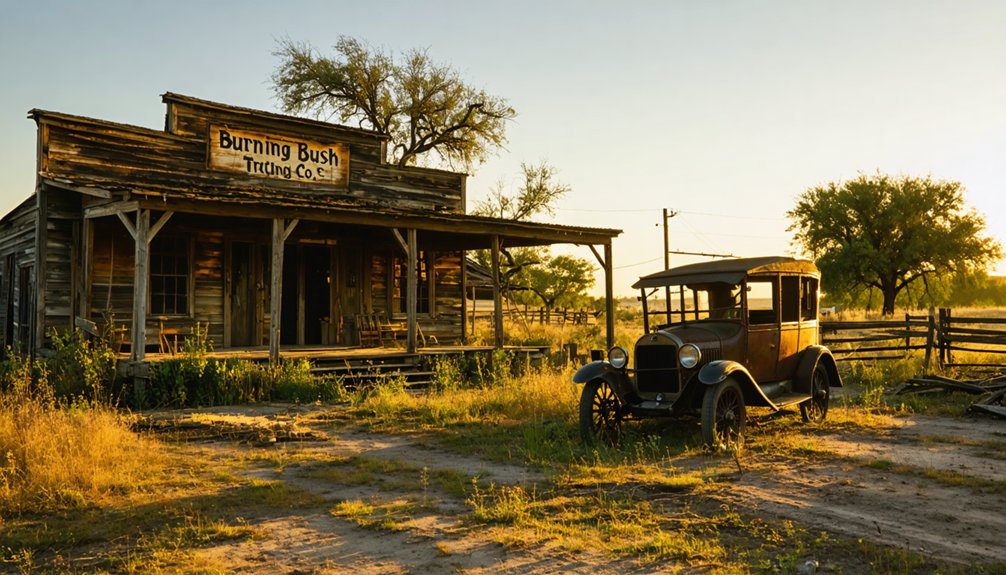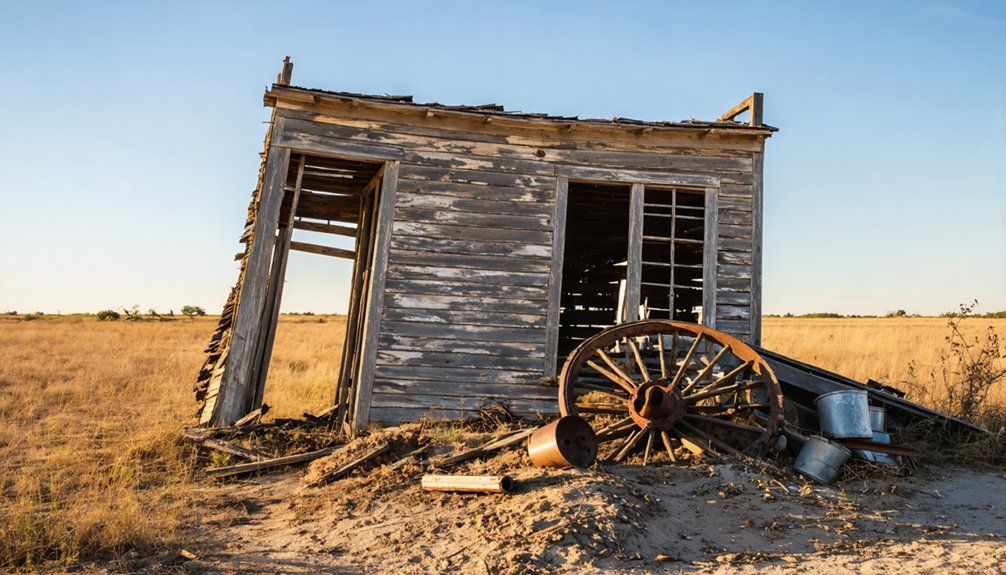You’ll find the remnants of Burning Bush Colony, a 1912 Free Methodist offshoot community, on a former 1,520-acre Texas plantation. The “Holy Jumpers,” known for their energetic worship, created a self-sufficient religious commune with modern farming equipment, a power plant, and communal dining halls. Though the settlement lasted only until 1919, you can still spot crumbling ruins and aging pecan orchards near the Texas Historical Commission marker. The site’s fascinating story of spiritual idealism and agricultural struggle runs deeper than its visible remains.
Key Takeaways
- Burning Bush Colony was a 1,520-acre religious commune established in Texas in 1912 by the Society of the Burning Bush.
- The colony featured advanced infrastructure including a power plant, sawmill, and communal dining halls before dissolving in 1919.
- Few physical structures remain today, with only crumbling ruins, old wells, and pecan orchards marking the former settlement.
- A Texas Historical Commission marker now stands at the site, providing historical context for visitors to the ghost town.
- The colony’s failure stemmed from agricultural struggles, unfamiliarity with Texas farming conditions, and an unsustainable economic model.
Methodist Origins and Religious Foundation
When the Society of the Burning Bush broke away from the Free Methodist Church in the early 1900s, they established several intentional communities across America, including the Burning Bush Colony near Bullard, Texas in 1912.
The Burning Bush Society’s schism birthed new spiritual settlements, as devout believers sought to build intentional Christian communities across early 1900s America.
This Methodist separation led 375 devoted followers to settle on a 1,520-acre farm, creating a unique experiment in communal spirituality.
You’ll find that these settlers weren’t your typical Methodist congregation. They surrendered their personal possessions upon joining, sharing everything from food to labor in pursuit of a purified Christian life.
Their large tabernacle became the heart of community worship, while their connection to the Metropolitan Church Association reinforced their evangelical mission. Like Wesley’s original Holy Club at Oxford, they maintained strict religious study and devotional practices.
They rejected formal church structures in favor of revival-style meetings, communal prayers, and strict moral codes aligned with Methodist holiness traditions. Known for their energetic worship services, members earned the nickname Holy Jumpers from observers.
From Plantation to Colony: The Land Purchase
After several years of cultivating pecan and plum trees on his East Texas property, Charles Palmer sold the land in 1907 that would become the Burning Bush Colony.
The Society of the Burning Bush exchanged properties in Idaho, Illinois, and New Mexico to acquire the Texas plantation in 1912.
The land acquisition took place during a time when Texas property ownership was evolving from its historic roots of Spanish and Mexican land grants to private sales and development.
Palmer’s agricultural endeavors had established the property’s potential for farming, with the pecan orchard remaining as the sole visible remnant today.
While the colony’s founders envisioned agricultural self-sufficiency on this fertile soil, economic challenges would ultimately doom their communal experiment.
The colony initially thrived with wealthy backers D. M. Farson and Edwin Harvey providing financial support.
Life on the Agricultural Settlement
You’d find the Burning Bush colonists toiling together in their fields from sunrise, working modern machinery to cultivate truck crops and tend to their expansive fruit orchards.
The community’s lack of southern farming expertise led them to struggle with crop yields, despite their organized system of sharing labor and equipment across their 1,520-acre plantation.
Like many farmers in the region during the 1920s, they faced severe agricultural depression that tested their resilience and resolve.
Everyone participated in harvesting and processing the bounty, which was distributed through their communal dining hall and sold at local markets to sustain the colony’s needs.
The colony operated its own sawmill and powerplant to support daily operations, demonstrating their commitment to self-sufficiency.
Daily Farm Operations
Life on Burning Bush Colony revolved around a meticulously organized daily farm schedule, where every hour served a specific purpose in maintaining the settlement’s agricultural success.
You’d find colonists up before dawn, tending to livestock and ensuring proper feed rations across their diverse animal holdings. Careful crop rotation practices helped maintain soil fertility, while their innovative livestock management system integrated grazing patterns with field operations. Much like modern farmers who practice holistic intensive grazing, the settlers understood the importance of strategic animal rotation for optimal land use.
As the day progressed, you’d see settlers splitting their efforts between equipment maintenance, field inspections, and meticulous recordkeeping. They’d distribute manure across fields, repair fences, and monitor irrigation systems – especially critical given Texas’s unpredictable rainfall. Like today’s small-scale farmers, these settlers faced significant economic pressures that threatened their agricultural way of life.
Every evening, they’d secure buildings and prepare for the next day’s tasks, following a rhythm that sustained their independent agricultural community throughout the seasons.
Communal Growing Methods
The communal farming approach at Burning Bush Colony marked a stark departure from traditional Texas agricultural methods of the time. You’d find no individual plots or private ownership here – instead, members surrendered all property rights to work the 1,520 acres as one unified force.
The colony’s collective harvests came from their pecan and plum orchards, worked by teams following strict daily schedules that blended farm work with worship.
While they’d access to modern equipment, their isolation and lack of regional farming expertise held them back. You wouldn’t see typical Texas practices like crop rotation or effective pest management.
Instead, they relied on their communal spirit, sharing meals and labor equally while operating their own infrastructure – from sawmills to power plants – all in service of their agricultural mission.
Distribution of Harvests
Once harvests were complete at Burning Bush Colony, every member surrendered their agricultural yields to the church authority, marking a stark departure from traditional farming settlements.
You’d find no individual ownership of crops here – everything went straight to the communal stores for distribution through the colony’s dining hall.
Despite their modern farming equipment acquired between 1907-1913, the communal harvests faced significant agricultural challenges.
The settlers’ unfamiliarity with Texas growing conditions and harsh climate led to consistently poor yields.
While the colony maintained impressive infrastructure including its own sawmill and power plant to support crop processing, their focus on subsistence rather than market participation ultimately proved unsustainable.
The religious doctrine that mandated this complete sharing of resources couldn’t overcome the practical difficulties of feeding the community, contributing to the colony’s dissolution by 1919.
Daily Routines and Community Practices

You’d find the daily rhythm of the Burning Bush Colony centered around both religious devotion and agricultural labor, with members gathering for morning prayers before heading to their assigned farm work.
The colony’s religious calendar marked important Methodist observances in the tabernacle, while the agricultural schedule followed the natural seasons of planting, tending, and harvesting across their 1,520 acres.
From dawn to dusk, you’d witness residents moving between the communal fields, shared facilities, and worship gatherings – all part of their structured approach to balancing spiritual and practical needs.
Similar to the La Reunion colony that once thrived in Dallas County, they cultivated strong agricultural practices to sustain their community.
The community maintained strong ties to their Free Methodist origins, setting them apart from traditional Methodist practices.
Religious Activities Calendar
Daily rhythms at Burning Bush Colony revolved around an intricate schedule of worship and work, with religious activities woven throughout each day’s duties.
You’d find yourself joining communal gatherings in the wooden tabernacle, where worship schedules included energetic services filled with jumping, backflips, and spontaneous expressions of religious fervor.
As a member, you’d participate in daily prayer meetings and worship sessions that bookended your work duties.
The colony’s strict religious calendar demanded your presence at mandatory services, where you’d join others in spirited singing from their published hymnals.
When disciplinary issues arose, you’d witness public prayer and wailing sessions.
Throughout the day, you’d gather with fellow believers in the communal dining hall, reinforcing the colony’s dedication to shared living and collective devotion.
Daily Farm Work Schedule
At sunrise, life on the Burning Bush Colony farm sprang into action as members gathered their communal tools and headed to the fields.
You’d find workers dispersed across the grounds, tending to livestock and crops according to strict community schedules. The day began with essential tasks – feeding chickens, milking cows, and checking the beehives.
Throughout the day, you’d see colonists working shoulder-to-shoulder in the fields, managing crop rotation, irrigation, and pest control. Despite having access to modern equipment, they chose manual labor to strengthen their communal bonds.
The workday didn’t end until sunset, with members taking scheduled breaks only for communal meals in the shared kitchen.
Every colonist surrendered their earnings and possessions to the collective, reinforcing their commitment to a unified, classless farming society.
Architectural Remains and Historical Sites
While the original Burning Bush Colony flourished with an impressive array of structures in the early 1900s, today’s visitors will find few physical remnants of this once-vibrant religious community near Bullard, Texas.
The colony’s architectural significance centered on a former plantation mansion that served as its headquarters, surrounded by family homes, gender-segregated dormitories, and a wooden tabernacle for worship.
You’ll discover the site’s historical context through a Texas Historical Commission marker, though the original buildings haven’t survived.
Some crumbling ruins, including an old barn, remain on private property, and you can spot pecan orchards that mark the colony’s original location.
The settlement’s advanced infrastructure – including its own power plant, water system, and sawmill – demonstrated remarkable foresight for a rural Texas community of that era.
Agricultural Legacy in East Texas

The agricultural legacy of Burning Bush Colony reflects broader transformations in East Texas farming after the Civil War, when the plantation system gave way to tenant farming and sharecropping.
East Texas agriculture underwent profound changes after the Civil War as plantations dissolved into a complex system of tenant farming and sharecropping arrangements.
You’ll find that local farmers adapted to the crop-lien system, primarily growing cotton to secure merchant credit, while the arrival of the International and Great Northern Railroad opened new markets.
As agricultural innovations spread through East Texas, you’ll see how Burning Bush Colony’s farmers embraced crop diversification beyond cotton.
They’ve incorporated ancient wisdom from indigenous Caddo cultivation of corn, beans, and squash, while adding modern crops like soybeans and peanuts.
Despite challenges of labor shortages and water conservation, the region’s farmers have shown remarkable resilience, contributing to Texas’s position as the nation’s fourth-largest agricultural producer.
Northern Migration to Southern Soil
In 1912, a remarkable northward-to-southward migration brought 375 members of the Metropolitan Church Association to East Texas soil, where they established Burning Bush Colony near Bullard.
You’ll find that these northern migrants, led by Chicago financiers Duke M. Farson and Edwin L. Harvey, left their personal belongings behind to pursue a communal lifestyle rooted in Free Methodist principles.
Their northern ideals of shared resources and evangelical worship clashed with southern realities as they struggled to adapt their community model to Texas climate and agriculture.
While they’d established similar colonies in Virginia, West Virginia, and Louisiana, this Texas venture proved particularly challenging.
The settlers’ dreams of self-sufficiency on 1,520 acres ultimately faltered under poor crop yields and financial strain, leading to the colony’s dissolution by 1919.
The Colony’s Brief Timeline

Marking a defining chapter in East Texas history, Burning Bush Colony‘s twelve-year existence unfolded through distinct phases of hope and hardship.
The colony timeline began in 1907 when Charles Palmer purchased the land, establishing a communal settlement focused on pecan and plum cultivation.
You’ll find that the historical events that followed revealed mounting challenges, as the community struggled to maintain self-sufficiency despite their collective wage system.
By 1919, financial pressures reached their peak with $12,000 in debt owed to merchant J.L. Vanderver.
The colony’s story reached its conclusion on April 15, 1919, when the sheriff auctioned the property to Vanderver for $1,000.
Most colonists then scattered northward, leaving behind their dreams and a pecan orchard that still stands today.
Preservation Efforts and Current Status
Despite its historical significance, Burning Bush Colony exists today primarily through scattered physical remnants and historical documentation rather than preserved structures.
You’ll find only a grove of aging fruit and nut trees and several old wells marking where this once-vibrant community stood. The site faces substantial preservation challenges, as it hasn’t received formal conservation status or dedicated funding from state or federal programs.
While the Texas State Historical Association maintains the colony’s memory through published entries, there’s limited community engagement through organized preservation efforts or heritage tourism initiatives.
You won’t find maintained trails or visitor centers – just historical markers telling the story. The ghost town’s physical deterioration and lack of standing structures have made it difficult to secure institutional support for preservation, leaving its legacy mainly in regional historical records.
Impact on Regional Religious Movements
Through its vibrant spiritual practices and radical communal lifestyle, the Burning Bush Colony left an indelible mark on religious movements across Texas and the American South. Their ecstatic worship style, featuring jumping, backflips, and spontaneous expressions of faith, influenced emerging Pentecostal congregations throughout the region.
The colony’s communal influence extended far beyond its physical boundaries through:
- Their “Burning Bush” publication, reaching over 100,000 readers nationwide
- The establishment of sister colonies in Wisconsin, Virginia, West Virginia, and Louisiana
- Their radical economic model of total surrender, which challenged traditional Methodist tithing practices
You’ll find traces of their legacy in modern-day intentional communities and the expressive worship styles that characterize many Southern Protestant churches, showing how their bold spiritual experiment shaped regional religious diversity.
Frequently Asked Questions
What Caused the Final Abandonment of Burning Bush Colony?
Ever wonder why utopian dreams crumble? You’ll find Burning Bush Colony’s fate sealed by financial losses, failed farming ventures, and economic decline. Without sustainable income, they couldn’t maintain the land, forcing their 1919 dispersal.
Were There Any Conflicts Between Colony Members and Surrounding Communities?
You won’t find much evidence of territorial disputes or violent conflicts. The colony’s unusual religious practices and financial troubles strained community relations, mostly leading to social isolation rather than direct confrontations.
How Many Families Originally Settled in the Burning Bush Colony?
Like checking TikTok analytics from 1913, you can’t find exact family demographics for the colony, but settlement patterns suggest the 400 members likely represented several dozen families plus individual settlers.
Did Any Descendants of Colony Members Remain in the Bullard Area?
While you’ll find a small number stayed after 1919, the descendant legacy is hard to trace. Community ties dissolved as remaining families integrated into Bullard’s population, with little documented evidence of their continued presence.
What Crops Were Most Profitable for the Burning Bush Colony Farmers?
You’ll find corn yields were their primary profitable crop, though results weren’t impressive. Cotton production existed but wasn’t as lucrative due to their communal farming approach and limited agricultural expertise.
References
- https://digging-history.com/category/ghost-town-wednesday/page/3/
- https://digging-history.com/2015/03/04/ghost-town-wednesday-burning-bush-colony-texas/
- https://en.wikipedia.org/wiki/List_of_ghost_towns_in_Texas
- http://texasghosttowns.blogspot.com/2011/
- https://www.texasescapes.com/EastTexasTowns/Burning-Bush-Texas.htm
- https://discovertexasoutdoors.com/places/burning-bush-colony/
- https://www.ghosttowns.com/states/tx/burningbush.html
- https://www.tshaonline.org/handbook/entries/burning-bush-colony
- https://en.wikipedia.org/wiki/Metropolitan_Church_Association
- http://divinityarchive.com/bitstream/handle/11258/4554/02466410.pdf?sequence=1&isAllowed=y



